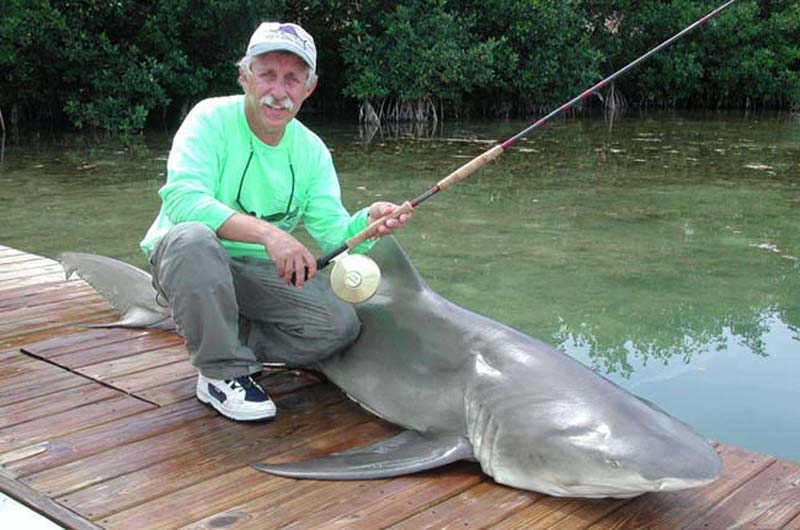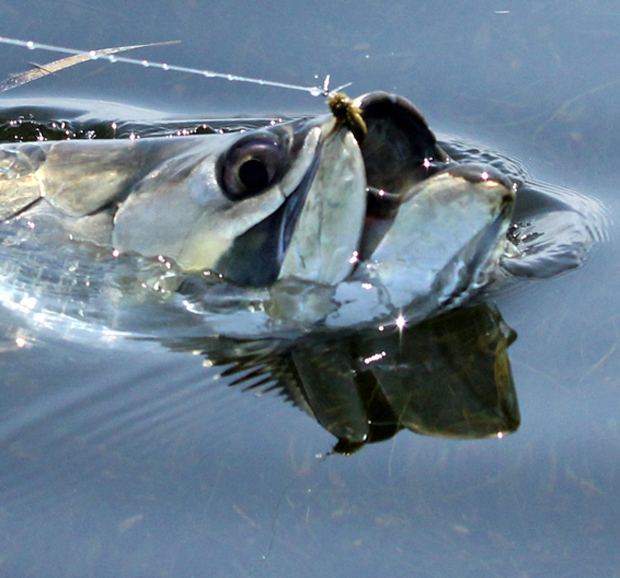
Twenty pound class tippet IGFA WORLD RECORD Spearfish [Tetrapturus angustirostris] on the Fly. It was caught by Wanda Hair Taylor aboard the vessel shown – Northern Lights on February 6, 2019 off Kona, Hawaii.Wanda was attending Jake Jordan’s Spearfish School with Captain Keven Nakamaru along with mates Dave and Kyle. Wanda was using a TFO HEAVY DUTY blue water fly rod, with a Mako #9700 Fly Reel. Jake Jordan, Wanda Taylor, and Capt. Nakamaruare are IGFA riging proponents.
Some of my friends state that if you’re not following the IGFA rules, you’re not even fishing. Yes, I’m serious. Take famous anglers like George Sawley, Diana Rudolph, Sandy Moret, Jake Jordan, Nick Smith, Marty Arostegui, Wanda Taylor, or Steve Huff, who always rig IGFA.
During a discourse with a friend about IGFA rigging, it became apparent that neither of us knew what the rules were – in exact detail. We both ‘mostly’ rig according to IGFA rules, or so we thought. Curiosity killed the cat – so what exactly are the rules? In detail, it seems that the authors of the IGFA rules were probably not fly fishers, or so it seems. A 12-inch shock tippet limit! Try landing a sail or a big shark? Can it be done? Yes.
Capt. George Sawley used to manage more than a 1,000 or more billfish in a single season – all rigged IGFA. But, you’ve got to admit that rigging IGFA and fly fishing for big animals is decidedly a disadvantage versus conventional, or All-Tackle rigging as the IGFA calls it. Add to the downside that a 20-pound test tippet is a limit! Nonetheless, rules are rules, and that keeps us all on a level playing field.
The following are IGFA’s Fly Fishing Rules:
Equipment Regulations
A. LINE
Any type of fly line and backing may be used. The breaking strength of the fly line and backing are not restricted.
B. LEADER
Leaders must conform to generally accepted fly fishing customs. A leader includes a class tippet and, optionally, a shock tippet. A butt or taper section between the fly line and the class tippet shall also be considered part of the leader and there are no limits on its length, material, or strength. A class tippet must be made of nonmetallic material and either attached directly to the fly or to the shock tippet if one is used. The class tippet must be at least 15-inches (38.10 cm) long (measured inside connecting knots). With respect to knotless, tapered leaders, the terminal 15-inches (38.10 cm) will also determine tippet class. There is no maximum length limitation. A shock tippet, not to exceed 12-inches (30.48 cm) in length, may be added to the class tippet and tied to the lure. It can be made of any type of material, and there is no limit on its breaking strength. The shock tippet is measured from the eye of the hook to the single strand of class tippet and includes any knots used to connect the shock tippet to the class tippet. In the case of a tan-dem hook fly, the shock tippet shall be measured from the eye of the leading hook.
C. ROD
Regardless of material used or number of sections, rods must conform and cast according to generally accepted fly fishing customs and practices. A rod shall not measure less than 6-feet (1.82 m) in overall length and any rod that gives the angler an unsporting advantage will be disqualified. Overall butt length may not exceed six inches when measured from the center of the reel foot to the end of the butt. Overall butt length for two-handed or spey rods longer than 11-feet may not exceed 10-inches when measured from the center of the reel foot to the end of the butt.
D. REEL
The reel must be designed expressly for fly fishing. There are no restrictions on gear ratio or type of drag employed except where the angler would gain an unfair advantage. Electric or electronically operated reels are prohibited.
E. HOOKS
A conventional fly may be dressed on a single or double hook or two single hooks in tandem. The second hook in any tandem fly must not extend beyond the wing material. The eyes of the hooks shall be no farther than 6-inches (15.24 cm)apart. Treble hooks are prohibited.
F. FLIES
The fly must be a recognized type of artificial fly, which includes streamer, bucktail, tube fly, wet fly, dry fly, nymph, popper and bug. The use of any other type of lure or natural or preserved bait, either singularly or attached to the fly, is expressly prohibited. Only a single fly is allowed. Dropper flies are prohibited. The fact that a lure can be cast with a fly rod is not evidence in itself that it fits the definition of a fly. The use of any lure designed to entangle or foul hook a fish is prohibited. No scent, either natural or artificial is allowed on flies. The use of scented material in a fly is prohibited.
G. GAFFS & NETS
Gaffs and nets used to boat or land a fish must not exceed 8-feet (2.44 meters) in overall length. (When fishing from a bridge, pier or other high stationary structure, this length limitation does not apply.) The use of a flying gaff is not permitted. Only a single hook is permitted on any gaff. Harpoon or lance attachments are prohibited. A rope or any extension cannot be attached to the gaff.
Angling Regulations
1. The angler must cast, hook, fight, and bring the fish to gaff or net unaided by any other person. No other person may touch any part of the tackle during the playing of the fish or give aid other than taking the leader for gaffing or netting purposes. Anyone assisting a shore-bound or wading angler must be within a rods length of the angler before touching the leader or netting or gaffing the fish.
2. Casting and retrieving must be carried out in accordance with normal customs and generally accepted practices. The major criterion in casting is that the weight of the line must carry the fly rather than the weight of the fly carrying the line. Trolling a fly behind a moving water craft is not permitted. The craft must be completely out of gear both at the time the fly is presented to the fish and during the retrieve. The maximum amount of line that can be stripped off the reel is 120-feet (36.57 meters) from the fly.
3. Once a fish is hooked, the tackle may not be altered in any way, with the exception of adding an extension butt. A harness cannot be attached to the fly rod.
4. Fish must be hooked on the fly in use. If a small fish takes the fly and a larger fish swallows the smaller fish, the catch will be disallowed.
5. One or more people may assist in gaffing or netting the fish.
6. The angling and equipment regulations shall apply until the fish is weighed.

Dr. Marty Arostegui with a world record lemon shark [385-pounds] caught in Key West, Florida. Arostegui holds more IGFA world records on a fly than anyone ever did, and Ralph Delph, Key West chapter captain, was party to many of Marty’s accomplishments. Delph Fishing is a Key West legend.
The following acts will disqualify a catch:
1. Failure to comply with equipment or angling regulations.
2. The act of persons other than the angler in touching any part of the rod, reel, or line either bodily or with any device during the playing of the fish, or in giving any aid other than that allowed in the rules and regulations. If an obstacle to the passage of the line through the rod guides has to be removed from the line, then the obstacle shall be held and cut free. Under no circumstances should the line be held or touched by anyone other than the angler during this process.
3. Resting the rod on any part of the boat, or on any other object while playing the fish.
4. Handlining or using a handline or rope attached in any manner to the angler’s line or leader for the purpose of holding or lifting the fish.
5. Intentionally foul hooking or snagging a fish.
6. Shooting, harpooning, or lancing any fish (including sharks and halibut) at any stage of the catch.
7. Chumming with the flesh, blood, skin, or any part of mammals.
8. Using a boat or device to beach or drive a fish into shallow water in order to deprive the fish of its normal ability to swim.
9. Attaching the angler’s line or leader to part of a boat or other object for the purpose of holding or lifting the fish.
10. If a fish escapes before gaffing or netting and is recaptured by any method other than as outlined in the angling rules.
11. When a rod breaks (while the fish is being played) in a manner that reduces its length below minimum dimensions or severely impairs its angling characteristics.
12. When a fish is hooked or entangled on more than one line.
13. Mutilation to the fish, prior to landing or boating the catch, caused by sharks, other fish, mammals, or propellers that remove or penetrate the flesh. (Injuries caused by leader or line, scratches, old healed scars or regeneration deformities are not considered to be disqualifying injuries.) Any mutilation on the fish must be shown in a photograph and fully explained in a separate report accompanying the record application.
Join the IGFA and stand up for overfishing, get the scoop on the WORLD of angling, enjoy hundreds of events, visit a world class museum and library, and enjoy your copy of World Record Game Fishes book.








